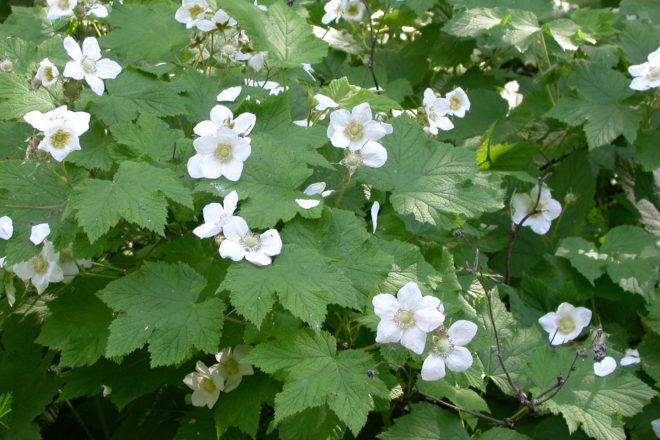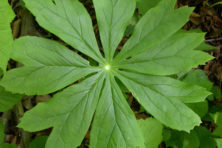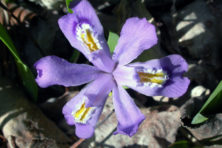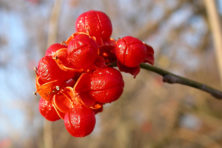Door to Nature: Thimbleberry Flowers and Fruit
- Share
- Tweet
- Pin
- Share

Many wild, white-flowered plants reach center stage during the last week of June in northeastern Wisconsin. The Canada anemone, Canada dogwood, highbush cranberry, oxeye daisy, red dogwood and thimbleberry are all decked out in their immaculate white.
The species that we will keep clearly in mind throughout July, patiently waiting for its delectable fruit to ripen, is the thimbleberry: Rubus (ROO-bus) parviflorus (par-vi-FLOR-us). Some people call the blackcap raspberry, Rubus occidentalis, the thimbleberry. Its leaflets are whitish and felty on the undersides.
Far more people know the genuine thimbleberry to be the large, juicy, red raspberry, with tiny seeds and tart flesh born on smooth canes with huge, handsome, maple-like, textured leaves. Few areas within its entire range are more famous for this favorite wild berry than Michigan’s Upper Peninsula.

The red, ripe thimbleberry fruit is tart and has small seeds. Photo by Roy Lukes.
Some years ago, a national TV weatherman held a jar of thimbleberry jam sent to him by people in the UP and said, “Nowhere else in the entire world does this marvelous berry plant grow!” It actually ranges from the Bruce Peninsula in Ontario, across the upper Great Lakes region to southern Alaska, into the Black Hills of South Dakota and south to the mountains of Mexico, Arizona and California.
There is little doubt in my mind that this sought-after fruit is at its very best in lands bordering the upper Great Lakes. The growing conditions in northeastern Wisconsin – always near the cool Lake Michigan shore, but away from the water’s edge – are similar to those encountered at a specific altitude on the wooded mountain slopes of the West.
Perhaps no plant genus – other than the Crataegus (thornapple) genus – is in such a chaotic condition as the Rubus when it comes to Latin names and identities. The genus has 250 to 700 species!
The outstanding thimbleberry is one of the well-proven and studied species. One place to admire them is along the roads bordering Lake Michigan northeast of Sturgeon Bay. Their large, five-petaled blossoms remind me of a single white rose set against handsome, deep-green leaves that are very slightly tacky to the touch and impart a clean, subtle perfume to the surrounding air. This would be my idea for a can of air freshener: clean, invigorating, but not overpowering or artificial.
What a pleasure it is to carefully walk through a patch of thimbleberries as you pick the fruit: no thorns! You don’t have to wear a suit of armor as when picking blackberries, when you earn every berry plucked off those thorny canes.
Prepare yourself for some slow pail-filling when you go in search of thimbleberries. Then line your pail with several of the huge plant leaves to cushion the delicate fruit as you put it into the container. Walk slowly and carefully because the huge, dense foliage tends to hide fallen logs.
I remember going to pick some thimbleberries one mid-morning during the dry summer of 1976. I was going through the rocky south point of Baileys Harbor with a plastic ice cream pail and had picked enough berries to cover its bottom when I looked at my watch. Holy cow! It was time to get home to make Roy his lunch. I hastened back to my car, and as I did, I tripped over a fallen tree, spilling all of my fruit onto the rough, rocky ground. That was it for my thimbleberry harvest that summer.
Thimbleberries tend to flatten when picked, and it’s important to pick them clean because it’s very difficult to pick out debris once they’re in the pail. When you’ve picked a pailful, you really have a lot of berries.
The recipe that Miss Emma Toft gave us is to combine equal quantities of clean berries and sugar in a pot, cook the mixture slowly, stir it well and bring it to a boil. Then quickly remove the pot from the burner, fill sterilized jars with the fruit and place sterilized lids on the jars.
The red color is exquisite; the seeds are very small and easy to chew compared to the large, woody seeds of blackberries; and the tart flavor is unsurpassable.
A good memory I have is of hiking the quiet trails on Rock Island in early August just after it became a state park. There was no campground, and few people were there. We hiked the trails leisurely, snacking on wild raspberries and thimbleberries and feeling like Robinson Crusoe, alone on a desert island.



